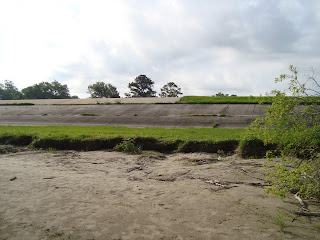I might be off on my days, because I think this is more like day 8, but whatever.
We crossed the border into Louisiana on Route 61, which was smaller than the interstate so our photo at the border wasn't as perilous.
We are staying on the Oak Alley plantation, on the west bank of the Mississippi in St. James Parish between New Orleans and Baton Rouge. We picked this one to see because it has a little glamor but also seemed to do a good job with researching and portraying conditions on the plantation, at least on-line. This has been true on the ground too.
The plantation was started in 1837 or so for sugar by Jacques Roman and his wife, Celina. The greater Roman family owned a bunch of plantations along this strip. Jacques died nine years later, and the plantation limped along under Celina and her son Andre until war broke out in 1861. Louisiana was taken by the Union pretty quickly (with lots of revolts after) and they basically lost the plantation until sometime after the war, but things fell apart. It was completely abandoned for a while and for 12 years cows lived freely in the house (longer than Jacques did!) It was restored in 1925 and is now in some sort of non-profit status.
We had a great tour of the house, followed by checking out the well done depiction of the slave quarters and slave life. It was topped off by a presentation about the sugar industry then-and-now with a hilarious but disturbing video by the sugar growers. I filmed a clip of it below. If you can play it, check it out! Apparently sugar does not cause diabetes or obesity and you should eat as much as you'd like! I'm going to be showing this to the med students next year when I teach these things. It's pretty similar to the old tobacco advertising.
We learned that the oaks (Virginia Live Oaks) were planted sometime around 1670, 150 years before the plantation was established! They don't really know by whom (they're pretty clearly human-planted) but probably by French settlers. They cause a sort of wind tunnel effect, pulling cooler air from the Mississippi to the house. You can feel it standing on the porch of the house. These are really cool trees, with some of the branches coming down to the ground and apparently rooting there.
The house/plantation had 113 slaves at its peak in 1848. About 1200 acres, most of it growing sugar cane.
OK, I'm out of gas. Have to plan our major drive to Birmingham tomorrow before dinner.
Louisiana border. Sort of missed low on the selfie.
Missed high on this one.
Maddy getting dwarfed on Oak Alley
It is definitely one hell of an alley!
Harry's toes in the Mississippi this morning.
Other parts of Harry on the Mississippi this morning.
River boat docked at Oak Alley.
40 foot levee at Oak Alley, from the river side. They used to be 5 feet when it was a plantation.








No comments:
Post a Comment